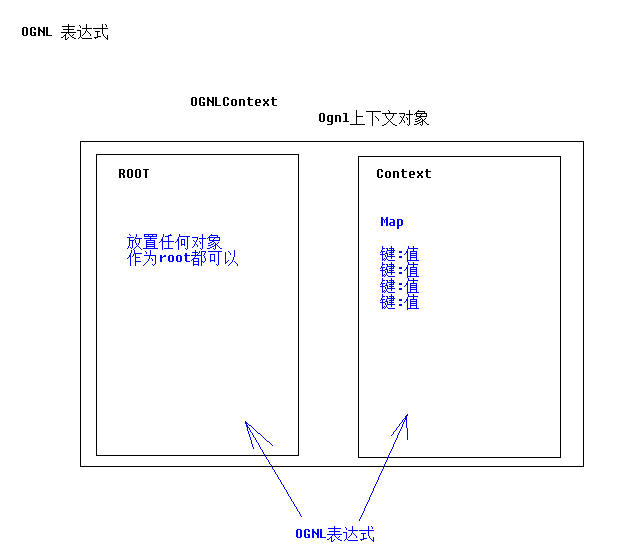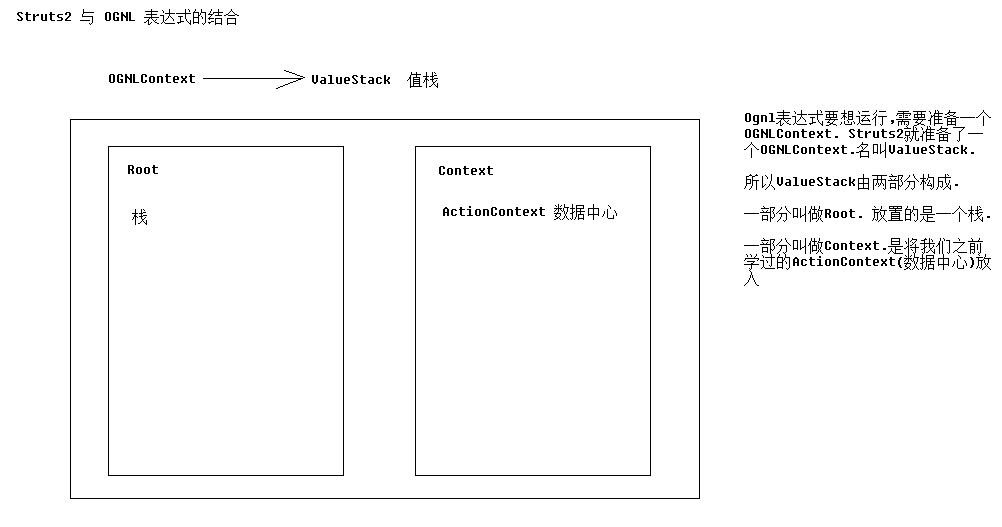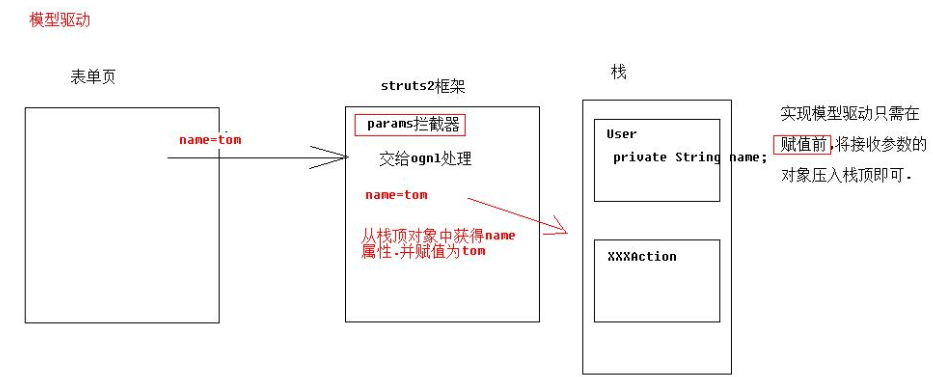Struts2学习笔记四 OGNL
OGNL,全称为Object-Graph Navigation Language(对象图表达语言),它是一个功能强大的表达式语言,用来获取和设置Java对象的属性,调用java对象的方法,同时能够自动实现必要的类型转换。它旨在提供一个更高的更抽象的层次来对Java对象图进行导航。如果把表达式看作是一个带有语义的字符串,那么OGNL无疑成为了这个语义字符串与Java对象之间沟通的桥梁。
OGNL:对象视图导航语言. ${user.addr.name} 这种写法就叫对象视图导航.
OGNL不仅仅可以视图导航.支持比EL表达式更加丰富的功能.
OGNL的作用
Struts默认的表达式语言就是OGNL,它具有以下特点:
- 支持对象方法调用。
- 支持类静态方法调用和值访问,表达式的格式为@[类全名(包括包路径)]@[方法名|值名],例如:@java.lang.String@format('foo%s','bar')。
- 支持赋值操作和表达式串联。例如:price=100,discount=0.8,calculatePrice(),在方法中进行乘法计算会返回80.
- 访问OGNL上下文(OGNL context)和ActionContext。
- 操作集合对象。
OGNL的要素
1、表达式
表达式是整个OGNL的核心,OGNL会根据表达式去对象中取值。所有OGNL操作都是针对表达式解析后进行的。它表明了此次OGNL操作要“做什么”。表达式就是一个带有语法含义的字符串,这个字符串规定了操作的类型和操作的内容。OGNL支持大量的表达式语法,不仅支持这种“链式”对象访问路径,还支持在表达式中进行简单的计算。
2、根(root)对象
Root对象可以理解为OGNL的操作对象,表达式规定了“做什么”,而Root对象则规定了“对谁操作”。OGNL称为对象图导航语言,所谓对象图,即以任意一个对象为根,通过OGNL可以访问与这个对象关联的其他对象。
3、上下文(context)对象
实际上OGNL的取值还需要一个上下文环境。设置了Root对象,OGNL可以对Root对象进行取值或写值等操作,Root对象所在环境就是OGNL的上下文环境。上下文环境规定了OGNL的操作“在哪里进行”。上下文环境Context是一个Map类型的对象,在表达式中访问Context中的对象,需要使用"#"号加上对象名称,即“#对象名称”的形式。
OGNL的入门
struts2 的包中已经包含了,所以不需要导入额外的jar包。

OGNL取值
@Test
//基本语法演示
//取出context中的属性值
public void fun3() throws Exception{
//准备ONGLContext
//准备Root
User rootUser = new User("tom",18);
//准备Context
Map<String,User> context = new HashMap<String,User>();
context.put("user1", new User("jack",18));
context.put("user2", new User("rose",22));
OgnlContext oc = new OgnlContext();
oc.setRoot(rootUser);
oc.setValues(context);
//书写OGNL
//取出root中user对象的name属性
String name = (String) Ognl.getValue("name", oc, oc.getRoot());
Integer age = (Integer) Ognl.getValue("age", oc, oc.getRoot());
System.out.println(name);
System.out.println(age);
//取出context中键为user1对象的name属性
String name = (String) Ognl.getValue("#user1.name", oc, oc.getRoot());
String name2 = (String) Ognl.getValue("#user2.name", oc, oc.getRoot());
Integer age = (Integer) Ognl.getValue("#user2.age", oc, oc.getRoot());
System.out.println(name);
System.out.println(name2);
System.out.println(age);
}
对于使用上下文的OGNL,若不指定从哪一个对象中查找"name"属性,则OGNL直接从根对象(root)查找,若指定查找对象(使用'#'号指定,如#user1),则从指定的对象中查找,若指定对象不在上下文中则会抛出异常,即使用#user1.name形式指定查找对象则必须要保证指定对象在上下文环境中。
OGNL为属性赋值
@Test
//基本语法演示
//为属性赋值
public void fun4() throws Exception{
//准备ONGLContext
//准备Root
User rootUser = new User("tom",18);
//准备Context
Map<String,User> context = new HashMap<String,User>();
context.put("user1", new User("jack",18));
context.put("user2", new User("rose",22));
OgnlContext oc = new OgnlContext();
oc.setRoot(rootUser);
oc.setValues(context);
//书写OGNL
//将root中的user对象的name属性赋值
Ognl.getValue("name='jerry'", oc, oc.getRoot());
String name = (String) Ognl.getValue("name", oc, oc.getRoot());
//把user1的name改为xq,并取值,如果多个取值放在一起,只会返回最后一个表达式的值
String name2 = (String) Ognl.getValue("#user1.name='xq',#user1.name", oc, oc.getRoot());
System.out.println(name);
System.out.println(name2);
}
OGNL调用方法
@Test
//基本语法演示
//调用方法
public void fun5() throws Exception{
//准备ONGLContext
//准备Root
User rootUser = new User("tom",18);
//准备Context
Map<String,User> context = new HashMap<String,User>();
context.put("user1", new User("jack",18));
context.put("user2", new User("rose",22));
OgnlContext oc = new OgnlContext();
oc.setRoot(rootUser);
oc.setValues(context);
//书写OGNL //调用root中user对象的setName方法
Ognl.getValue("setName('lilei')", oc, oc.getRoot());
String name = (String) Ognl.getValue("getName()", oc, oc.getRoot()); String name2 = (String) Ognl.getValue("#user1.setName('lucy'),#user1.getName()", oc, oc.getRoot());
System.out.println(name);
System.out.println(name2);
}
OGNL调用静态方法
@Test
//基本语法演示
//调用静态方法
public void fun6() throws Exception{
//准备ONGLContext
//准备Root
User rootUser = new User("tom",18);
//准备Context
Map<String,User> context = new HashMap<String,User>();
context.put("user1", new User("jack",18));
context.put("user2", new User("rose",22));
OgnlContext oc = new OgnlContext();
oc.setRoot(rootUser);
oc.setValues(context);
//书写OGNL String name = (String) Ognl.getValue("@java.lang.String@format('hello %s!','world')", oc, oc.getRoot());
//Double pi = (Double) Ognl.getValue("@java.lang.Math@PI", oc, oc.getRoot());
Double pi = (Double) Ognl.getValue("@@PI", oc, oc.getRoot());
System.out.println(name);
System.out.println(pi);
}
创建list对象
@Test
//基本语法演示
//ognl创建对象-list|map
public void fun7() throws Exception{
//准备ONGLContext
//准备Root
User rootUser = new User("tom",18);
//准备Context
Map<String,User> context = new HashMap<String,User>();
context.put("user1", new User("jack",18));
context.put("user2", new User("rose",22));
OgnlContext oc = new OgnlContext();
oc.setRoot(rootUser);
oc.setValues(context);
//书写OGNL //创建list对象
Integer size = (Integer) Ognl.getValue("{'tom','jerry','jack','rose'}.size()", oc, oc.getRoot());
String name = (String) Ognl.getValue("{'tom','jerry','jack','rose'}[0]", oc, oc.getRoot());
String name2 = (String) Ognl.getValue("{'tom','jerry','jack','rose'}.get(1)", oc, oc.getRoot()); System.out.println(size);
System.out.println(name);
System.out.println(name2);
//创建Map对象(#表示要创建一个map)
Integer size2 = (Integer) Ognl.getValue("#{'name':'tom','age':18}.size()", oc, oc.getRoot());
String name3 = (String) Ognl.getValue("#{'name':'tom','age':18}['name']", oc, oc.getRoot());
Integer age = (Integer) Ognl.getValue("#{'name':'tom','age':18}.get('age')", oc, oc.getRoot());
System.out.println(size2);
System.out.println(name3);
System.out.println(age);
}
OGNL与Struts2结合

什么是值栈?
具体参考这里,ValueStack是Struts的一个接口,OGNLValueStack是ValueStack的实现类,客户端发起一个请求Struts2架构会创建一个action实例,同时创建一个OgnlValueStack值栈实例,OgnlValueStack贯穿整个Action的生命周期,Struts2中使用OGNL将请求Action的参数封装为对象存储到值栈中,并通过OGNL表达式读取值栈中的对象属性值。
CompoundRoot root;
transient Map<String, Object> context;
Context:即OgnlContext上下文,它是一个map结构,上下文中存储了一些引用,parameters、request、session、application等,上下文的Root为CompoundRoot。
OgnlContext中的一些引用:
- parameters:该Map中包含当前请求的请求参数。
- request:该Map中包含当前request对象中的所有属性。
- session:该Map中包含当前session对象中的所有属性。
- application:该Map中包含当前application对象中的所有属性。
- attr:该map按如下顺序来检索某个属性:request,session,application
CompoundRoot:存储了action实例,它作为OgnlContext的Root对象。action实例位于栈顶,当读取action的属性值时会先从栈顶对象中找对应的属性,如果找不到则继续找栈中的其他对象,如果找到则停止查找。
CompoundRoot继承了ArrayList实现压栈和出栈功能,拥有栈的特点,先进后出,最后压进栈的数据在栈顶。我们把它称为对象栈。
Struts2对原OGNL做出的改进就是Root使用CompoundRoot(自定义栈),使用OgnlValueStack的findValue方法可以在CompoundRoot中从栈顶向栈底找查找的对象的属性值。
ActionContext和ValueStack的关系
PrepareOperations源码:
public ActionContext createActionContext(HttpServletRequest request, HttpServletResponse response) {
Integer counter = Integer.valueOf(1);
Integer oldCounter = (Integer)request.getAttribute("__cleanup_recursion_counter");
if(oldCounter != null) {
counter = Integer.valueOf(oldCounter.intValue() + 1);
}
ActionContext oldContext = ActionContext.getContext();
ActionContext ctx;
if(oldContext != null) {
ctx = new ActionContext(new HashMap(oldContext.getContextMap()));
} else {
ValueStack stack = ((ValueStackFactory)this.dispatcher.getContainer().getInstance(ValueStackFactory.class)).createValueStack();
stack.getContext().putAll(this.dispatcher.createContextMap(request, response, (ActionMapping)null));
ctx = new ActionContext(stack.getContext());
}
request.setAttribute("__cleanup_recursion_counter", counter);
ActionContext.setContext(ctx);
return ctx;
}
从上源码可以看出:
在创建ActionContext的时候,创建ValueStack的对象,将ValueStack对象给ActionContext。
ActionContext中有一个ValueStack的引用。ValueStack中也有一个ActionContext的引用。
ActionContext获取Servlet API的时候,就依赖值栈。
获取值栈对象
1、通过ActionContext对象获取值栈
ValueStack stack1= ActionContext.getContext().getValueStack();
2、通过request域获取值栈
ValueStack stack2= (ValueStack)ServletActionContext.getRequest().getAttribute(ServletActionContext.STRUTS_VALUESTACK_KEY);
查看值栈中两部分内容(使用DEBUG标签)
<%@ page language="java" contentType="text/html; charset=UTF-8"
pageEncoding="UTF-8"%>
<%@ taglib prefix="s" uri="/struts-tags" %>
<!DOCTYPE html PUBLIC "-//W3C//DTD HTML 4.01 Transitional//EN" "http://www.w3.org/TR/html4/loose.dtd">
<html>
<head>
<meta http-equiv="Content-Type" content="text/html; charset=UTF-8">
<title>Insert title here</title>
</head>
<body>
<!-- 调试标签 -->
<s:debug></s:debug>
</body>
</html>
struts2与ognl结合体现—参数接收

必须在params拦截器之前,把对象压入栈顶。可以使用parpre拦截器,只需在action中实现Preparable接口即可。具体参考这里。
public class Demo2Action implements Preparable {
private User u = new User();
@Override
public String execute() throws Exception {
System.out.println(u);
return SUCCESS;
}
@Override
public void prepare() throws Exception {
//压入栈顶
//1获得值栈
ValueStack vs = ActionContext.getContext().getValueStack();
//2将u压入栈顶
vs.push(u);
}
}
struts2与ognl结合体现—配置文件
import com.opensymphony.xwork2.ActionSupport;
public class Demo3Action extends ActionSupport {
private String name;
@Override
public String execute() throws Exception {
name = "jerry";
return SUCCESS;
}
public String getName() {
return name;
}
public void setName(String name) {
this.name = name;
}
}
<action name="Demo3Action" class="cn.itheima.d_config.Demo3Action" method="execute" >
<result name="success" type="redirectAction" >
<param name="actionName">Demo1Action</param>
<param name="namespace">/</param>
<!-- 如果添加的参数struts"看不懂".就会作为参数附加重定向的路径之后.
如果参数是动态的.可以使用${}包裹ognl表达式.动态取值
-->
<param name="name">${name}</param>
</result>
</action>
扩展:request对象的getAttribute方法,查找顺序

Struts2学习笔记四 OGNL的更多相关文章
- struts2学习笔记四
一.contextMap中的数据操作 root根:List 元素1 元素2 元素3 元素4 元素5 contextMap:Map key value application Map key value ...
- Struts2学习笔记(OGNL表达式)
Struts 2支持以下几种表达式语言: OGNL(Object-Graph Navigation Language),可以方便地操作对象属性的开源表达式语言: JSTL(JSP Standard T ...
- Struts2学习笔记四:深入拦截器
一:拦截器的工作原理 拦截器的执行过程可以类比filter过滤器,ActionInvocation实例执行过程中,先执行action实例上引用的拦截器们,然后才执行action实例处理请求,返回res ...
- Struts2学习笔记(四)——result结果类型
当Action类的方法处理请求后,会返回一个字符串(逻辑视图名),框架根据这个结果码选择对应的result,向用户输出,所以需要在struts.xml提供<result>元素定义结果页面, ...
- Struts2 学习笔记(概述)
Struts2 学习笔记 2015年3月7日11:02:55 MVC思想 Strust2的MVC对应关系如下: 在MVC三个模块当中,struts2对应关系如下: Model: 负责封装应用的状态,并 ...
- C#可扩展编程之MEF学习笔记(四):见证奇迹的时刻
前面三篇讲了MEF的基础和基本到导入导出方法,下面就是见证MEF真正魅力所在的时刻.如果没有看过前面的文章,请到我的博客首页查看. 前面我们都是在一个项目中写了一个类来测试的,但实际开发中,我们往往要 ...
- IOS学习笔记(四)之UITextField和UITextView控件学习
IOS学习笔记(四)之UITextField和UITextView控件学习(博客地址:http://blog.csdn.net/developer_jiangqq) Author:hmjiangqq ...
- java之jvm学习笔记四(安全管理器)
java之jvm学习笔记四(安全管理器) 前面已经简述了java的安全模型的两个组成部分(类装载器,class文件校验器),接下来学习的是java安全模型的另外一个重要组成部分安全管理器. 安全管理器 ...
- Struts2学习笔记⑧
今天是Struts2学习笔记的最后一篇文章了.用什么做结尾呢,这两天其实还学了很多东西,没有记录下,今天就查漏补缺一下. 文件上传与下载.FreeMarker以及昨天没做完的例子 文件上传与下载 文件 ...
随机推荐
- UniCode 下 CString 转 char* 的方法(转)
转自:http://blog.csdn.net/neverup_/article/details/5664733 今天进行文件操作时,将CString的GetBuffer()后直接倒到char数组后写 ...
- GridView 翻页 索引超出范围
事件回顾 今天GridView翻页时,又遇到错误:索引超出范围.必须为非负值并小于集合大小. 这是当时的PageIndexChanging和RowCommand两个事件的后台代码 protected ...
- TP5 数组分页
需要 use think\Page; 我这个是 Page是从tp3.2的移到5.0来用的,如果你的里面没有这个也可以移动过来 PHP代码: $page= $this->request->p ...
- [HAOI2012]高速公路
题面在这里 题意 维护区间加操作+询问区间任选两不同点途中线段权值之和的期望 sol 一道假的期望题... 因为所有事件的发生概率都相同,所以答案就是所有方案的权值总和/总方案数 因为区间加法自然想到 ...
- [HAOI2010]软件安装
简单的tarjan+(本蒟蒻刚刚接触不久)恶心的树形DP 题面 题目描述 现在我们的手头有N个软件,对于一个软件i,它要占用Wi的磁盘空间,它的价值为Vi.我们希望从中选择一些软件安装到一台磁盘容量为 ...
- Linux性能分析工具与图形化方法
欢迎大家前往腾讯云+社区,获取更多腾讯海量技术实践干货哦~. 作者:赵坤|腾讯魔王工作室后台开发工程师 在项目开发中,经常会遇到程序启动时间过长.CPU使用率过高等问题,这个时候需要依靠性能分析工具来 ...
- 基于python自动化测试平台与虚拟化技术结合的思考
背景: 自动化测试行业内,个人觉得主力语言是python.java.这里讨论下基于python自动化框架设计与case开发,用过python的都知道它的好处,但是根据实际项目需要有了很多迎面而来的困难 ...
- 状压dp入门
状压dp的含义 在我们解决动态规划题目的时候,dp数组最重要的一维就是保存状态信息,但是有些题目它的具有dp的特性,并且状态较多,如果直接保存的可能需要三维甚至多维数组,这样在题目允许的内存下势必是开 ...
- jemeter 实现接口自动化回归测试
jemeter做接口自动化测试的优点: 1.首先我认为最重要的是不需要编程基础,很多一直想做接口测试但一直徘徊在门边的原因可能就是不想写代码 2.可以更快的上手,能让测试人员更好的理解什么是接口测试, ...
- 设计模式——原型模式(C++实现)
#include <iostream> #include <string> using namespace std; class CPrototype { public: CP ...
